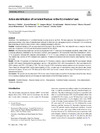Identificador persistente para citar o vincular este elemento:
https://accedacris.ulpgc.es/jspui/handle/10553/127181
| Título: | Active identification of vertebral fracture in the FLS model of care | Autores/as: | Rubiño, Francisco J. Naranjo, Antonio Molina, Amparo Fuentes, Sonia Ortega Santana, Francisco Cándido Navarro, Ricardo Montesdeoca, Arturo Fernández, Tito Lorenzo, José Antonio Ojeda, Soledas |
Clasificación UNESCO: | 320714 Osteopatología | Palabras clave: | Vertebral fracture Fracture liaison service Osteoporosis Vertebral fracture assessment Bone densitometry, et al. |
Fecha de publicación: | 2023 | Publicación seriada: | Archives of Osteoporosis | Resumen: | Summary : The identification of vertebral fracture is a key point in an FLS. We have analyzed the characteristics of 570 patients according to the route of identification (referral by other doctors, emergency registry or through VFA), concluding that promoting referral by other doctors with a training campaign is effective. Purpose: Vertebral fractures (VF) are associated with increased risk of further VFs. Our objective was to analyze the characteristics of patients with VF seen in a Fracture Liaison Service (FLS). Methods: An observational study was carried out on patients with VF referred to the outpatient metabolic clinic (OMC) after a training campaign, identified in the emergency registry, and captured by VF assessment with bone densitometry (DXA-VFA) in patients with non-VFs. Patients with traumatic VF or VF > 1 year, infiltrative or neoplastic disease were excluded. The number and severity of VFs (Genant) were analyzed. Treatment initiation in the first 6 months after baseline visit was reviewed. Results: Overall, 570 patients were included, mean age 73. The most common route for identifying VF was through referral to OMC (303 cases), followed by the emergency registry (198) and DXA-VFA (69). Osteoporosis by DXA was found in 312 (58%) patients and 259 (45%) had ≥ 2 VFs. The rate of grade 3 VFs was highest among patients on the emergency registry. Those identified through OMC had a higher number of VFs, a higher rate of osteoporosis, more risk factors and greater treatment initiation. Patients with VFs detected by DXA-VFA were mostly women with a single VF and had a lower rate of osteoporosis by DXA. Conclusions: We present the distribution of VFs by the route of identification in an FLS. Promoting referral by other doctors with a training campaign may help in the quality improvement of the FLS-based model of care. | URI: | https://accedacris.ulpgc.es/handle/10553/127181 | ISSN: | 1862-3522 | DOI: | 10.1007/s11657-023-01289-9 | Fuente: | Archives of Osteoporosis [ISSN 1862-3522], v. 18, artículo 89, 2023 |
| Colección: | Artículos |
Visitas
26
actualizado el 16-mar-2024
Descargas
13
actualizado el 16-mar-2024
Google ScholarTM
Verifica
Altmetric
Comparte
Exporta metadatos
Los elementos en ULPGC accedaCRIS están protegidos por derechos de autor con todos los derechos reservados, a menos que se indique lo contrario.
